
- Ethnic African American
- Format
- Isbn
- 0194735043668 (2)
- 9780028973456 (4)
- 9780195160192 (2)
- 9780195170559 (3)
- 9780199995394 (6)
- 9780231131841 (3)
- 9780393066968 (6)
- 9780739171745 (3)
- 9780748637140 (3)
- 9780810884885 (2)
- 9780826150059 (2)
- 9780840359025 (2)
- 9780938410812 (4)
- 9780943412078 (6)
- 9781438494920 (2)
- 9781524763138 (2)
- 9781570036262 (2)
- 9781793510921 (2)
- 9781851097692 (2)
- 9781934435892 (3)
- Other (1117)
- Item Height
- Item Length
- Language
- Type
- Artist Doll (75)
- Baby Doll (18)
- Bracelet (6)
- Collectible (12)
- Doll (19)
- Doll Playset (14)
- Fashion Doll (136)
- Figure (9)
- Figurine (10)
- Hardcover (14)
- Necklace (8)
- Painting (91)
- Photograph (213)
- Play Doll (14)
- Porcelain Doll (22)
- Print (115)
- Rag & Cloth Doll (16)
- Reborn Doll (7)
- Sculpture (7)
- Textbook (40)
- Other (332)
Southern Black African American Louisiana Folk Art Oil Painting ALVIN BATISTE

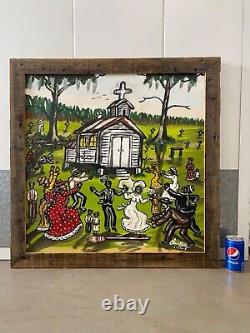
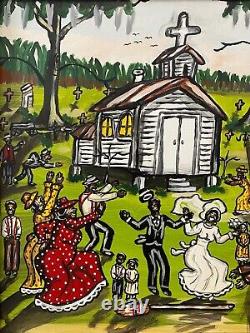
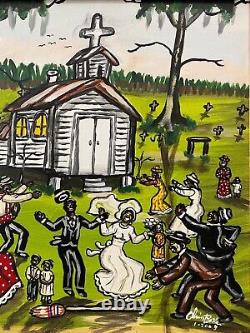
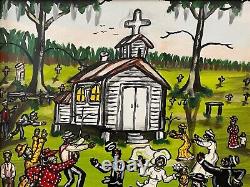
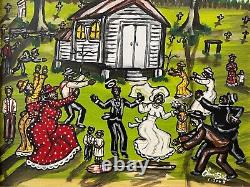
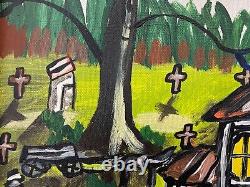

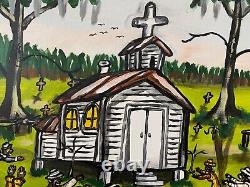


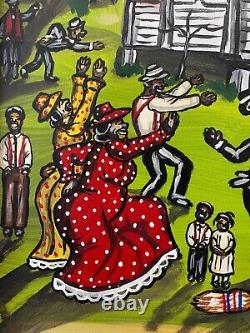
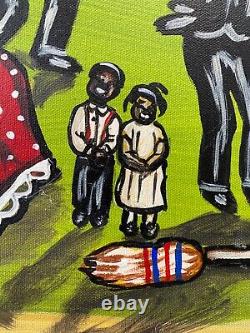

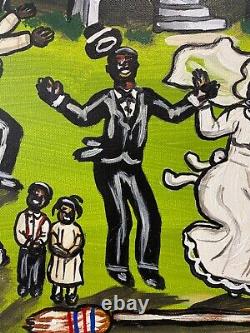

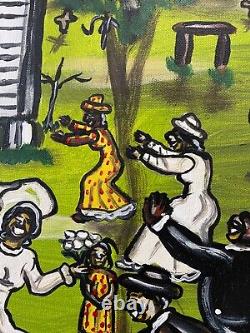
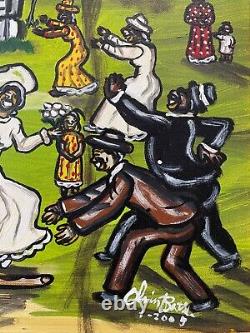
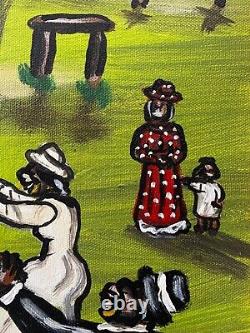
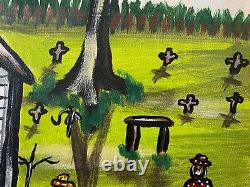
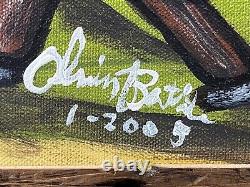


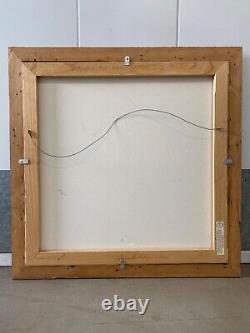


This is a wonderful and jubilant Southern Black African American Louisiana Folk Art Oil Painting on canvas, by regionally renowned and avidly collected Louisiana based African American Folk Artist, Alvin Batiste b. This piece is titled: "Jumping the Brome" on the top stretcher bar of the verso and depicts a jovial traditional Louisiana African American wedding scene. Figures in bright colored clothing dance around a happy bride and groom, who jump over a broom laid on the grass.
In the background, a small white chapel and an old graveyard can be seen. Signed and dated: "Alvin Batiste 1-2005" in the lower right corner. Additionally, this piece is signed: "Alvin Batiste" on the lower right stretcher bar of the verso. Approximately 27 1/4 x 27 1/4 inches including frame. Actual artwork is approximately 24 x 24 inches.
Good condition for age and storage, with some light scuffing and edge wear to the rustic wood frame. Acquired from an affluent private collection in Los Angeles County, California. Batiste's artworks have been exhibited and displayed at the West Baton Rouge Museum, the River Road African American Museum, McNeese University, The Arts Council of Baton Rouge, and have been collected by notable figures such as Billy Bob Thornton, Kathryn Crosby, and John Foise, among others. If you like what you see, I encourage you to make an Offer. Please check out my listings for more wonderful and unique artworks!Alvin Batiste (Born 1962) is active/lives in Louisiana. Alvin Batiste is known for Painting. The place is Framerdave's Frame Shop, located on a small street in an even smaller town, smack dab in the heart of Donaldsonville, LA.
It is here that Alvin has become Louisiana's premiere Folk Artist. This is the home of Alvin Batiste, unequivocally the most sought after and collected folk artist since the likes of Clementine Hunter. Alvin Batiste was born on march 16, 1962.It was his mother, Lillian Batiste that encouraged Alvin to paint from a very young age. Alvin has eulogized his mother's passing in 1997 by consistently reflecting on the love they shared for one another, capturing the stories she often told to entertain Alvin and his siblings. His mother's memory is his driving force.
And it is his God given gift that transposes those memories into paintings of life. If you haven't heard of Alvin Batiste, just ask Oscar winner Billy-Bob Thronton. Alvin Batiste was commissioned by Billy-Bob to create the artwork for his first album cover called Private Radio.
Recognizing that his peace comes from up above, Alvin Batiste has infectiously managed to capture the hearts and imaginations of people from every demographic. He is a visionary, a story teller and an artist's artist. The Folk Art of Alvin Batiste: Louisiana Culture Painted. Self-taught artist Alvin Joseph Batiste, a native of Donaldsonville, Louisiana, was born in 1962 and began drawing pictures at the age of three.
By the age of twenty-eight, Alvin Joseph Batiste began a riveting chapter in his life by becoming a full-time painter. Since then, Batiste, who still resides in Donaldsonville, has produced over 8,000 drawings and paintings, many of which are displayed in museums, galleries, and homes throughout the world.
Today he is a well-known artist who paints memories of his childhood, as well as myriad contemporary themes. Centered on family and faith, the Batiste household generated deeply rooted traditions. From the outset, his mother, Lillian Little Batiste, offered unconditional support to her son and served as the genesis for his artistic career.
Batiste's earliest childhood memory is of drawing on the floor with his father's carpentry pencils. To spare her household belongings, Lillian gave Batiste his older sister's school paper to sketch on-the first time his pen met paper.Lillian Batiste was her son's first private collector, hanging her son's sketches on her living room walls throughout the 1970s,'80s, and'90s. Since Lillian's passing in 1997, Batiste has eulogized his mother by manifesting her spirit as a driving force for his painting narrative. Her memory lives on through each brush stroke, and in 2010, he dedicated a painting to her as an everlasting spiritual eulogy: The Dream I Had Mama Came Got Everyone Ready Early One Morning; She Said It's Time For All The Saints To Get Ready. As a devout Christian, Batiste reads scriptures regularly before he begins a painting, often including biblical content and passages in his works. Interestingly, a collector may recognize these works by analyzing the back side of the painting, where one can often find a scripture verse tightly hand printed in marker.
As a child, Batiste's mother ensured there was a Bible in the house at all times, and his older sister read the scriptures with him regularly. Such experiences have since transformed into myriad illustrations of Heaven, referenced by Batiste's particular interest in Revelations, the biblical book composed of apocalyptic literature. In an effort to acknowledge his faith in God and memory of his mother's spirit, a majority of Batiste's painting narratives highlight an amalgamation of Heaven and Hell. In the process of portraying these potent subjects, Batiste paints with a creative spontaneity in an effort to keep faith and family close to his heart. The way in which Batiste is inspired by his family's tradition of storytelling is evident in Anitee MeMea's Oldtime Storys on the Porch (Figure 2).
In this beguiling portrait, Batiste depicts the importance of preserving the foundation of family. To help me in my efforts to learn more about Batiste's childhood experiences and their influences on his art, he has contributed countless hours of interviews for my research. These conversations provide a fascinating oral history of him and his family. His mother told stories to her children about being a teenager in the 1930s, when she cut sugar cane on Evergreen Plantation in Iberville, Louisiana. Her experience working on a cane field in the early twentieth century was similar to that of many newly-freed African-Americans in the post-Civil War years, who continued to work for planters in return for housing. Batiste explained that as his mother prepared to leave Evergreen, she met and married James Batiste Sr. Later having six children and settling in Donaldsonville. As I imagined the setting on the Batiste family porch when Batiste was growing up, I became interested in exploring whether the tradition of storytelling is becoming, or is already, endangered. Erica McCreedy offers a provocative suggestion in her article on Alvin Batiste.As the nation moves away from a focus on regional and local cultures and toward a need for globalization, oral history is often overlooked. With the acceleration of media and communication, the desire to maintain and preserve a culture's irreplaceable oral history has been cast aside in the past few decades.
Yet folk artist Alvin Batiste stands unassumingly in the middle of it all and through his primitive and wildly colorful paintings, revives the South's dire need for oral history preservation. The human experience surrounding events of the South Gulf Coast can only be sustained through the tradition of storytelling. In our present multimedia age, the effects of Hurricane Katrina in 2005 were documented more thoroughly for Louisiana, the United States and the world, than Hurricane Betsy, for example, was in 1965. The culture and traditions integral to Batiste's art, however, are challenged by such catastrophic events.
Batiste's series of hurricane -themed paintings poignantly capture Louisianians' traumatic experiences and his sympathy for the people who suffered. One of his hurricane-related scenes, People Making their Way to the Superdome (Figure 3), offers a visual synopsis of New Orleans during the days following Katrina. The focus of the scene, the New Orleans Superdome, is surrounded by a deluge of water, trapping the people surrounding it.
Another painting in this series, FEMA Trailers in Donaldsonville, symbolizes Batiste's tribute to residents who lost their homes to the flooding and destruction that followed Hurricane Rita in 2005. For nearly four years following the storm, trailers from the Federal Emergency Management Agency became a permanent part of the visual landscape of New Orleans, Donaldsonville, the river parishes, and the entire Gulf Coast region. Our grandmothers pass on stories of how Hurricane Betsy inundated Southeast Louisiana in 1965, but since Katrina's wrath in 2005, a subsequent generation will pass down analogous stories to their children and grandchildren. In Batiste's case, he continues to preserve such major events through the medium of paint. In addition to his hurricane subjects, Batiste's memories reflect plantation life and early vernacular architecture. He paints vanishing plantation structures often razed because of dilapidation. Set against nuances of brilliant hues and a monochrome sky, Plantation Life (Figure 4) shows two standing structures conveyed through a trancelike aesthetic; in contrast, the vivacity of the orange and yellow-green pigments trumps a silent story of a past time. In the foreground and middle ground, figures do outdoor chores such as laundry and attending livestock. By focusing on the goats and hogs in the pen, the viewer can recognize a telling detail of a hog pointing its snout towards the fence.When I asked the artist if he recalls any memories of his family having a farm, he commented: I can remember my grandmother's farm in [Plaquemines Parish, Louisiana], the cisterns, the outhouses, garden, and all the animals. I liked the goats but was afraid of the pigs; they were real big.
A cabin and outhouse are shown in Figure 4, but many of Batiste's paintings portray an entire plantation landscape ensemble, including smoke houses, quarters for field slaves, cisterns, and outdoor kitchens. However, in spite of the artist's success in visually preserving these early structures, only the big plantation house remains on many plantations today. John Michael Vlach, in Back of the Big House: The Architecture of Plantation Slavery, notes that visitors to historic plantation properties often remark, This is a beautiful home!While this kind of aesthetic perception of a plantation is valuable to its history, a focus on the history of slavery and the everyday lives of slaves is also needed. Batiste's painting narratives preserve such stories, enabling people to learn the histories of their ancestors.
Balancing on a pirogue and holding a long cypress stick with a hook at its end, the painted figures look upward in order to pick moss. A scene in the background shows how moss was boiled in large iron kettles, and then draped on a fence to dry in the sun. At the time, moss was substituted for cotton and utilized for pillow, mattress, and upholstery stuffing. Then as now, culinary traditions were central to plantation life, as well as to gatherings of friends, family, and community.
On innumerable canvases, Batiste shows how neighbors come together for a boucherie (the Louisiana French term for a hog butchering), a community gathering that combined work and entertainment. Such scenes demonstrate that plantation life on the Mississippi River Road Corridor was, and still is, centered on outdoor cooking. For example, Hog Killing Day on The Plantation , also known as Le Boucherie, depicts what was and is still a common and community practice in South Louisiana. On the history of the butchering of pigs in Louisiana, Sam Bower writes, Pork was consumed in some form continually, morning, noon, and night by all classes, sexes, ages, and conditions. Hog's lard is the very oil that moves the machinery of life (1972:63).To transition from Batiste's themes of outdoor cooking to his memories of indoor cooking is befitting, since the latter and former were equally important to the cuisine, cultures and community of Louisiana. For example, in a gripping painting titled Big Mama Gael Smoking Chicken (Figure 5), Batiste depicts an interior of a smoke house with dark walls blackened with soot. Mama Gael and the smoking barrel glow amongst six chicken carcasses in a dank environment. While the colors in this painting are particularly intriguing, it can be said that Batiste invented this composition in keeping with his personal admiration for culinary tradition. Similar to Miss Vicki in the Rice Field (Figure 6), Big Mama Gael Smoking Chicken denotes a culinary tradition that is perhaps unknown to most people today.
That is, Batiste explores the process of smoking meat in a smoke house. Meat was smoked for a few days, or as long as a week; the length of time and type of wood or fuel used depended on the desired flavor. As an addendum to the traditions Batiste learned from storytelling, he recalls teacakes, cookies, ginger bread, homemade bread, and meat pies as common food staples in the Batiste household. The family maintained a vegetable garden which James Batiste Sr. Batiste's father grew corn, mustard greens, okra, and tomatoes.Big Mama is a reoccurring subject in Batiste's paintings. She is consistently portrayed as a full-bodied woman, evoking a jovial demeanor, compassion, and character.
Batistes' early idea of Big Mama is simple: he wanted to paint a lady fishing and eating watermelon by the water, and that Big Mama represented all of the women who looked after him. Although Batiste has painted the Big Mama figure for eighteen years to date, these illustrations developed and evolved overtime. Today she is exhibited through a lens of varying roles, such as preparing meals, conducting outdoor chores, storytelling, cooking, fishing in the bayou, going to church, and working in a rice field. The technique exhibited in Miss Vicki in the Rice Field (Figure 6) signifies a mature style of painting. Batiste's brushstrokes convey magnificent energy, intentionally skewed proportions, strong colors, and a clear sense of the artist's autonomic direction.
This painting lures the viewer to an imaginative playground of color and character. Miss Vicki boisterously stands in an inland swamp where rice is grown in an accumulation of water. Batiste demonstrates that European planters lacked prior knowledge of rice farming, having planted it above ground like other crops, before African-born slaves taught them methods of successful cultivation. As shown through the figures in this essay, in Batiste's canon, neutralism is rare and passion for preserving culture is commonplace. Moreover, while Batiste is younger in age, one could argue that Batiste's talent and authenticity make him a contemporary to Louisiana folk artists Clementine Hunter, Sarah Albritton, and Sister Gertrude Morgan.
To recognize Batiste's artistic growth as a folk artist of high regard in southeast Louisiana, one can review hundreds of articles and press releases about his career. On many occasions, Batiste has been described as a "primitive artist" because he is self-taught and inspired by rural traditions. However, I would suggest that the term "folk artist" is more accurate in describing Batiste in the twenty-first century, because this title conveys a less archaic meaning than "primitive, " a pseudonym of the prehistoric. Although Batiste's art is sometimes labeled primitive, folk, visionary, naïve, outsider, or self-taught, he believes that he belongs to no specific school of art; he works within his own system of expression. As Nathalia Brodskaia writes in Naïve Art.
Despite the amazing diversity of naive artists, then, their relationship with professional art is basically the same. It would, after all, be extremely difficult to find a person who took up a brush and just started creating oil paintings without any previous knowledge of painting and without ever having seen the pictures of the great masters even by way of reproductions on postcards (2007:102). Folk art, including Batiste's work, is now valued by art museums that used to collect only "high" art. The River Road African American Museum in Donaldsonville holds dozens of Batiste's early and current works in its collection. Folk art in general is represented in the collections of virtually every major art museum, including the Ogden Museum of Southern Art in New Orleans and the American Folk Art Museum in New York.Museums around the world are now dedicated to the preservation and display of the genre. With that in mind, it can be said that Batiste's appreciation of local and international artists is an expression of the level of his artistic maturity. In order to advance as an artist, he has closely studied famous artists such as Matisse, Picasso, Henry Rousseau, Grant Wood, and Michelangelo, and is continually inspired by their artworks, lives, and artistic efforts. In short, the act of researching artists and their art in order to become inspired, whether or not he is placed within their genre, is a prominent facet of Batiste's artistic ambition.
Batiste's life-long dedication to being a professional artist suggests that there is no inherent difference in motivation between a rural and contemporary artist, and his prolific paintings are shaped by conventions of process, history, real life, and aesthetics. One of the artists Batiste admires, Henri Rousseau (Laval 1844 - Paris 1910), claimed that he had?
No teacher other than nature (New World Encyclopedia 2008, page version ID 682816). Rousseau rarely visited the exotic places depicted in his jungle-scene narratives, yet his paintings exhibit a familiarity with these places analogous to Batiste's methods of inspiration. Like Batiste, Rousseau painted subjects from books, stories, landscapes, and gardens that were in close proximity to his home.
Although Rousseau and Batiste are from different places and periods, the fact that both artists were born into rural livelihoods and communities gives them much in common. Each subject explored in this essay--Lillian Batiste, spiritualism, storytelling, hurricanes, plantation life, indoor cooking, Big Mama, and Batiste's artistic genre--confirms there is a place for rural thematic folk art, while reconfirming the affection Batiste has for preserving Louisiana's rich cultural tapestry. Batiste's work has been collected and displayed by the River Road African American Museum, McNeese University, The Arts Council of Baton Rouge, Billy Bob Thornton, Kathryn Crosby, and John Folse, among others.
He has been honored in several hundred reviews in print, media, and web publications, most notably the New York Times Travel Section in 2001. Among his important contributions to Louisiana are his donations to the Children's Miracle Network, the American Heart Association, and the American Cancer Society. Recently the Louisiana Department of Culture, Recreation, and Tourism, selected Batiste from one hundred artists to travel to Disney World to participate in "My Louisiana" and exhibit his artworks at Epcot's International Food and Wine Festival. Photography of paintings by Diana Buckley. This painting narrative developed from a story that Kathe Hambrick, director of the River Road African American Museum in Donaldsonville, told Batiste. Hog Meat and Hoe Cake: Food Supply in the Old South 1840 - 1860. Baton Rouge: Southern University Press. Alvin Batiste: Fighting to Preserve the Old South. The New York Times travel section, December 16, p. Back of the Big House: the Architecture of Plantation Slavery. Durham: University of North Carolina Press. Heart of Louisiana: Alvin Batiste.(WVUE) - His mother always encouraged him to draw and paint pictures. Now, a Donaldsonville folk artist is using his work to preserve the stories she told him, decades ago. Four days a week, you'll find Alvin Batiste sitting near a window in the front of Framer Dave's art shop in downtown Donaldsonville. "I like the swamp scene, so, I said,'that's what I'm going to do today, " Batiste said.
It takes him about an hour to create his south Louisiana swamp, with a fisherman smoking a pipe, an alligator, cypress trees and an egret. Just in the swamp, you know, catching fish. And there's a little cabin in the backgroud, Batiste said, describing his piece. The day began with a plastic cup of wine.Batiste said an occasional sip helps him relax. He started drawing when he was about 3 years old and his mother was impressed.
"She just started encouraging me to keep on with it, " he recalled. He bought a paint brush and water colors at the local five and dime and was inspired by stories he heard from his mother while he was growing up.
She used to be telling the story, I used to be sitting there with my sketch pad. Just, you know, sketching things out or whatever. And, she said,'One day, somebody could discover, you, your work,' Batiste said.
Now, he paints with acrylics on canvas, but the scenes are still inspired by his mother's stories. She used to tell me they would go every year to pick berries. And they used to have their baskets and stuff. And they used to pick a lot, all they want, he said. The paintings are outlined in black and are full of color.
Oh, I love colors, as you could see. I just put a lot of yellows, reds and stuff, Batiste said. He said he loves to create things people want to keep, take home with them and enjoy.
"It makes me feel good that people come in and they like it, and they say,'I'm going to hang it on my wall,'" Batiste said. As a self-taught folk artist, Batiste's creations have been displayed at art museums and featured in national publications. He's honed his craft by watching landscape art shows on TV, but occasionally, Batiste will create a self-portrait. The difficult thing is to get the face, the eyes and the mouth. But, most of the time when I do it, people say,'That looks just like you,' Batiste said. His images preserve a piece of local history, what life was like on the farm for the laborers, and daily life with a character Batiste calls Big Mama. It's an artist's way of retelling his own mother's stories. You can meet Batiste on most weekends, painting near the front window of Framer Dave's store. Catch up with local artist Alvin Batiste. Everyone in Donaldsonville knows Alvin Batiste. His unique paintings are seen everywhere around town, from inside the River Road African American Museum to Mayor Leroy Sullivan's office. His work was featured in a children's book authored by Mary Gehman last year: Cardy the Cardinal Finds a Home in Donaldsonville.But he will be featured in another children's book coming up, maybe in the next couple of months. "It's about swamp animals, " Batiste said at the recent 4th of July celebration at Crescent Park. Miss Grace wrote the story, and I painted all the pictures. I've been staying busy, painting. That opened up a dialogue for Batiste to discuss his career a little further.
Some people may not know that Batiste's work spreads beyond city limits. His art makes up the cover art for Billy Bob Thornton's 2001 album Private Radio. "They were filming in Donaldsonville, " Batiste said. Some of the people on set were looking through the window. They came in and bought some of my work.
A few days later, I took a day off and Billy Bob Thornton came in. He said,'Alvin, this is Billy Bob Thornton. I love your work, and I would love to meet you. I don't stay too far from work. So I walked over there and got a chance to meet him. I was just so excited to be doing his CD, you know. The 56-year-old artist said he listens to music at the shop everyday.He likes all sorts of music. He also likes the local radio, KKAY. Batiste appears younger than he is.
He says his home is in Donaldsonville, where he was born and raised. "I try to take care of myself, " he said.I try to keep in shape. I get a lot of exercise, and I try to eat right. Batiste lives with three older sisters.
He says they take care of each other. "Everybody pitches in, " he said.
Batiste attended Donaldsonville High School for two years. He actually did not begin painting until his late 20s. The medium he prefers is acrylic, but he said if he's not using acrylic, he's happy using water color on paper or pen and ink or pencil.I don't get bored with just doing one thing. I go back and forth. I used to always be daydreaming. I wanted to be an artist like Picasso.
He begins to name artists he admires: Rembrandt, Norman Rockwell, Andy Warhol, Henri Matisse, and Michelangelo. [Warhol] would take like soup cans and cutouts. It was different, but I kind of liked it [postmodern] and psychedelic. But Batiste's favorite is Bob Ross."I used to watch him every Saturday, " he said. Currently he has a gallery at Framer Dave's located on 512 Mississippi Street. Dave and Evie Imbraguglio, owners of the framing shop, love Batiste. Dave Imbraguglio has been framing since 1988, but they have been at the current address for six years.
Moreover, Batiste explained how the "moss pickers, " a truly beautiful painting hanging up in the local museum came to life. He said that Kathe Hambrick, founder of the River Road African American Museum, visited him one day at the shop and began talking about African moss harvesters. Moss was used to stuff pillows and mattresses. "She was just telling me the story, " he said. Later on I decided to get a canvas out and painted it. I kind of just had to use my imagination. Batiste said he prefers to paint people, for instance people working on a plantation. Next, although Batiste is somewhat tucked away in Donaldsonville, he's no real secret. Louisiana tourism has taken him to Howard University in Washington, he explained. And he got to go to Disney's Epcot Center. "A couple of musicians and some other artists went, " he said. Batiste holds Donaldsonville art near his heart. He used to set up shop on Railroad Avenue at the old Ben Franklin store, a "five and dime store, " he explained.He mentioned Miss Sandra Imbraguglio, Dave's mother. [Sandra] said,'Alvin, what you doing with all these paintings? I said I'm just doing it for my mom.
It was just a hobby for me. I was just having fun. My mom said keep going. Lillian Batiste, Alvin's mother passed away nearly 20 years ago, but he said she was a big influence on him. A homemaker, Lillian eventually retired and took care of the children. Alvin also has three brothers."Some of my siblings used to draw, but they didn't stick with it, " he said. Batiste said he is happy he stuck with it. I just enjoy what I do.
I would love to do more to promote tourism more in Louisiana. Maybe a commercial to tell people'Welcome to Donaldsonville.
It's a dream of mine. That and maybe have my own show like Bob Ross. Batiste the Artiste: Louisiana painter's work on display in Port Allen.More than 30 pieces of Alvin Batiste's art shown in the West Baton Rouge Museum. Through the large front window of FramerDave's Frame Shop in Donaldsonville, La.
Passersby can see multiple vibrant paintings consuming the walls. Seen through the corner is the creator of those pieces, Alvin Batiste. Batiste sits opposite a canvas, working on his next piece. Over the past decade, Batiste has become popular in the art community.
He now has an exhibit of his work at the West Baton Rouge Museum. His paintings have garnered the attention of actor Billy Bob Thornton and chef John Folse, and he has been honored in many publications, including The New York Times.
Batiste began sketching at the age of 5. His small drawings were well received by his friends and family, which inspired him to attempt painting. "I used to watch Bob Ross on television and admired his work, " Batiste said.
He inspired my style of painting. Batiste calls his style of art "folk" or "backyard" art.
Many of his pieces reflect events he has experienced or tales he has been told. A lot of it comes from stories my mom would tell me. Baptisms in the river, going to the church, planting gardens.It all influenced me, Batiste said. As his popularity increased, Batiste has been given the opportunity to travel the country displaying his art. Batiste journeyed to Washington, D. Where he had an exhibit in 2002 at Howard University. He also had a couple of paintings displayed in the Epcot Center at Disney World.
He "paints as he feels, " allowing his emotions to speak through his works. Batiste enjoys the praise he receives from the honesty in his paintings. Often pass by the window of the shop and commend Batiste on his work. When creating art, Batiste said he believes the most important thing is to remember where you came from. He said being down to earth allows an artist to observe everything around him and find even more inspiration. Batiste said coming from such a small town lets him see things that would be missed if he lived in a large city. However, he is also influenced by larger cities like New Orleans. "There's so much to do in big cities, " he said. I think it's great to put together small city and large city inspirations into my work.Rarely does Batiste take time off. He is in the shop painting five days a week for hours at a time. He will enter with a vision of what he wants on the canvas in front of him and work until that vision is complete. Batiste's folk art exhibit will remain in the West Baton Rouge Museum until March 30. Regular museum hours are Tuesday through Saturday from 10 a.
And Sunday from 2 p. This item is in the category "Art\Paintings". The seller is "willsusa_utzeqm" and is located in this country: US. This item can be shipped to United States.
- Artist: Alvin Batiste
- Signed By: Alvin Batiste
- Size: Medium
- Signed: Yes
- Period: Contemoporary (1970 - 2020)
- Title: \
- Material: Canvas, Oil
- Region of Origin: Louisiana, USA
- Framing: Framed
- Subject: Community Life, Dancing, Figures, Men, Women, Children
- Type: Painting
- Year of Production: 2005
- Original/Licensed Reproduction: Original
- Item Height: 27 1/4 in
- Style: Americana, Folk Art, Outsider Art
- Theme: Americana, Cultures & Ethnicities
- Features: One of a Kind (OOAK)
- Production Technique: Oil Painting
- Country/Region of Manufacture: United States
- Handmade: Yes
- Item Width: 27 1/4 in
- Time Period Produced: 2000-2009

